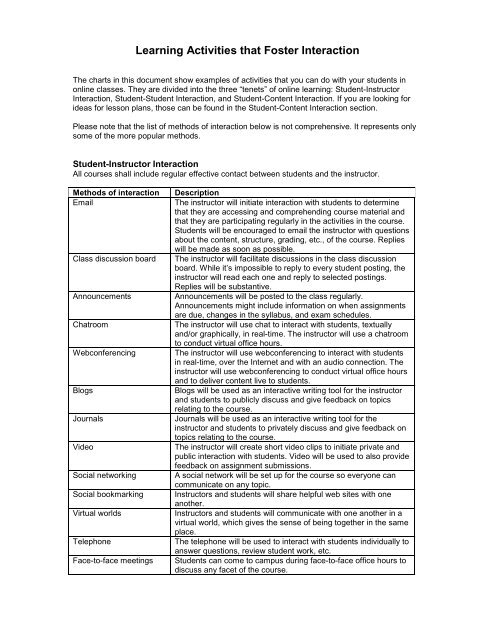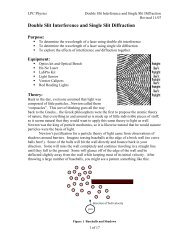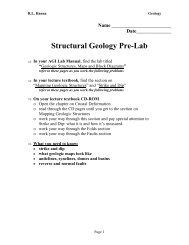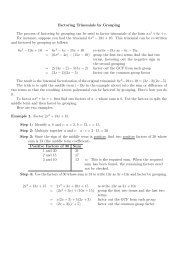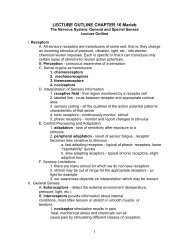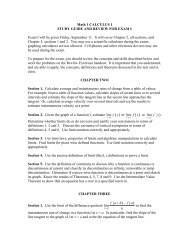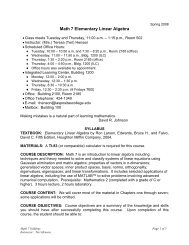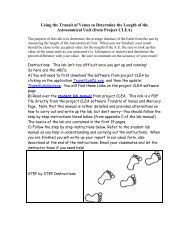Learning Activities that Foster Interaction
Learning Activities that Foster Interaction
Learning Activities that Foster Interaction
- No tags were found...
You also want an ePaper? Increase the reach of your titles
YUMPU automatically turns print PDFs into web optimized ePapers that Google loves.
<strong>Learning</strong> <strong>Activities</strong> <strong>that</strong> <strong>Foster</strong> <strong>Interaction</strong>The charts in this document show examples of activities <strong>that</strong> you can do with your students inonline classes. They are divided into the three “tenets” of online learning: Student-Instructor<strong>Interaction</strong>, Student-Student <strong>Interaction</strong>, and Student-Content <strong>Interaction</strong>. If you are looking forideas for lesson plans, those can be found in the Student-Content <strong>Interaction</strong> section.Please note <strong>that</strong> the list of methods of interaction below is not comprehensive. It represents onlysome of the more popular methods.Student-Instructor <strong>Interaction</strong>All courses shall include regular effective contact between students and the instructor.Methods of interactionEmailClass discussion boardAnnouncementsChatroomWebconferencingBlogsJournalsVideoSocial networkingSocial bookmarkingVirtual worldsTelephoneFace-to-face meetingsDescriptionThe instructor will initiate interaction with students to determine<strong>that</strong> they are accessing and comprehending course material and<strong>that</strong> they are participating regularly in the activities in the course.Students will be encouraged to email the instructor with questionsabout the content, structure, grading, etc., of the course. Replieswill be made as soon as possible.The instructor will facilitate discussions in the class discussionboard. While it’s impossible to reply to every student posting, theinstructor will read each one and reply to selected postings.Replies will be substantive.Announcements will be posted to the class regularly.Announcements might include information on when assignmentsare due, changes in the syllabus, and exam schedules.The instructor will use chat to interact with students, textuallyand/or graphically, in real-time. The instructor will use a chatroomto conduct virtual office hours.The instructor will use webconferencing to interact with studentsin real-time, over the Internet and with an audio connection. Theinstructor will use webconferencing to conduct virtual office hoursand to deliver content live to students.Blogs will be used as an interactive writing tool for the instructorand students to publicly discuss and give feedback on topicsrelating to the course.Journals will be used as an interactive writing tool for theinstructor and students to privately discuss and give feedback ontopics relating to the course.The instructor will create short video clips to initiate private andpublic interaction with students. Video will be used to also providefeedback on assignment submissions.A social network will be set up for the course so everyone cancommunicate on any topic.Instructors and students will share helpful web sites with oneanother.Instructors and students will communicate with one another in avirtual world, which gives the sense of being together in the sameplace.The telephone will be used to interact with students individually toanswer questions, review student work, etc.Students can come to campus during face-to-face office hours todiscuss any facet of the course.
ListservsThe instructor will communicate with all students simultaneouslyvia an email listserv. Student and instructor responses can alsobe emailed to everyone in the class.Student-Student <strong>Interaction</strong>Regular interaction among students is necessary to design a collaborative, student-centeredenvironment in which a community of learners is created.Methods of interactionEmailClass discussion boardGroup workBlogsChatPeer-editing/critiquingSocial networkingSocial bookmarkingWikisChatroomVirtual worldsDescription (add specifics for your course)Students will be encouraged to email each other to ask questionsabout the course, including assignments. They will complete atleast one assignment in which they use email to facilitate a peereditinglesson. An example assignment is…Students will post to the discussion board in each module,answering questions posed by the instructor. They will also replyto each others’ postings. An example assignment is…Students will work in teams to complete a group project. Thisproject will then be shared with the rest of the class in thediscussion board. An example assignment is…Students will use blogs to discuss topics in the course. They willalso use blogs in a writing assignment in which groupscollaborate to write a paper. An example assignment is…As an adjunct to the group discussion board, students will use theclass chatroom to discuss their group project in real-time. Anexample is…Students will use Google Docs for a peer-editing assignment.They will edit another student’s paper and give feedback directlyon the document. An example assignment is…A social network will be set up for the course so everyone cancommunicate on any topic.Students can share helpful web sites with one another.Wikis allow students to work collaboratively to build a web site.This can be particularly useful when groups have to create aproduct to share with the class. An example assignment is…As an adjunct to the group discussion board, students can usethe class chatroom to discuss their group project in real-time.Students can communicate with one another in a virtual world,which gives the sense of being together in the same place.Student-Content <strong>Interaction</strong>All student activities, including assessments, should be aligned to the outcomes of, andobjectives within, the course. <strong>Activities</strong> should also be designed to meet the needs of studentswith different learning styles. The content must cover all of the content detailed in the courseoutline of record.Methods of interactionClass discussion boardGroup workDescription (add specifics for your course)Each module will contain at least one class discussion relating tothe topic(s) of the module. Students will be required not only topost their opinions, ideas, and experiences, but they will also berequired to reply to their classmates’ posts. The instructor willpose questions relating to the textbook, online presentations, websites, etc. An example assignment is…There will be at least one group project during the semester.Students will collaborate in private groups to solve problems,
Methods of interaction Description (add specifics for your course)become experts on certain topics, etc. They will then present theirfindings to the class in the class discussion board. Thesepresentations will be in the form of writing, PowerPointpresentations, or web sites. An example assignment is…Written papersPapers will be written on various topics. Prior to studentssubmitting their work, papers will be checked by an antiplagiarismservice to ensure <strong>that</strong> no plagiarism is involved. Therewill be short papers on…Internet researchQuizzes, tests/examsPractice quizzesJournal writingMini-lecturesThere will be a term paper on…Students will use the Internet to research questions, problems,events, etc. Prior to students submitting papers, those papers willbe checked by an anti-plagiarism service to ensure <strong>that</strong> noplagiarism is involved. An example research assignment is…Quizzes will be used in each module to make sure studentscompleted the assigned reading and understood it. Thesequizzes will be “open-book”, but the questions will be randomizedso different students get different questions.Tests and exams will include short answer and essay questions<strong>that</strong> will require higher-order thinking, along with supportingfactual knowledge. The questions will be randomized so differentstudents get different questions. Time limits will be set,backtracking will be prohibited, and students will be forced tocomplete the exam in one sitting. A typical exam question is…Practice quizzes will be given periodically throughout the courseso students will be able to gauge their understanding of thecontent. Specifically, these ungraded practice quizzes will begiven prior to the midterm and final exam. These quizzes willinclude only objective questions so they can be graded by thecomputer, enabling students to gain immediate feedback.Students will maintain a journal to record reactions to topics beingstudied and to record personal reflections. In their journals,students will write…Written lecture material will be divided into short, readable(“chunked”) sections with links to subsequent pages, if necessary.For example, four mini-lectures, each with two short paragraphsper page, will be posted on the topic of…PowerPoint presentations—with or without audio narration—will be up to 5 minutes in duration but no longer than 10 minutes.Each module will contain one narrated PowerPoint presentation<strong>that</strong> covers the main points of the module. Deaf students will haveaccess to the narration via a text transcript. An examplepresentation will cover…Mobile learningSimulationsPodcast lectures will be chunked and up to 5 minutes in durationbut no longer than 10 minutes. Each module will contain onepodcast <strong>that</strong> covers the main points of the module. Deaf studentswill have access to the podcast via a text transcript. An examplepodcast will cover…Mini-lectures and other content can be processed so studentscan download them onto their mobile devices in order to learnwherever and whenever they want.Simulations can be used by students so they can participate in,and learn from, processes <strong>that</strong> might otherwise be less availablebecause of danger, expense or logistical difficulties. An examplesimulation for this course is...
Methods of interaction Description (add specifics for your course)VideoVideo can be used to demonstrate procedures and to helpstudents visualize concepts. These clips increase the modalitiesof learning offered to students and meet the needs of those wholearn best by seeing and hearing content.You can utilize online videos in various ways, including: 1. Pose aquestion at the beginning of the video to give students an idea ofwhat to expect, what to look for, and what might be worth thinkingabout; 2. Present videos in an outline-like structure using short,descriptive links to different segments <strong>that</strong> include running timesof each segment; 3. Include a short quiz or practice quiz at theend of each video; 4. Use the video as a springboard to a wholeclassdiscussion; and 5. Assign multiple short videos, then havestudents identify, compare, and contrast the concepts presentedin each.Virtual field tripsGamesBrainstormingProjectsePortfoliosPeer-editing/critiquingBlogsPolling/surveysDebatesDeaf students should have access to the videos closedcaptioning.Students will “attend” virtual field trips to places on web sites <strong>that</strong>are either too far away or too costly to visit in person. These fieldtrips will be followed by activities, such as discussions. Anexample field trip and corresponding activity are…Games will be used as review activities to reinforce previouslylearned material and to prepare for exams. Jeopardy!-stylegames, crossword puzzles, flash cards, etc., will be created foronline delivery. Games will be used to review for…Brainstorming will be used to promote creative thinking via freeassociation of ideas at the beginning of specific lessons. This willbe done in the discussion board. It will work best in the chatroom,but because the class is asynchronous, students will betterappreciate it being done in the discussion board. An examplebrainstorming activity will be…Students will complete a capstone project <strong>that</strong> demonstrates themastery of an outcome(s) of the course. This project will besubmitted either as a written paper, a PowerPoint presentation, ora web site. An example project is…Examples of student work can be uploaded to ePortfolios for eachstudent. You can use ePortfolios to assess student work.Students can use them to show their work to prospectiveemployers. Google Sites can be used to create ePortfolios.Students will work in pairs to edit each other’s paper and givefeedback in order to improve their writing. Email or Google Docswill be used as the tool to accomplish this. An exampleassignment is…Students will use blogs to discuss topics in the course. They willalso use blogs in a writing assignment in which groupscollaborate to write a paper. An example assignment is…In order to begin a discussion on a controversial issue, studentswill be polled to determine their stances. This will be done in theform of a survey. Results will be shared with students in anannouncement or in the discussion board prior to the discussion.An example poll will be…Debates will be used to expand upon both sides of an argument.Assigned students present their arguments, and fellow studentsrespond to them and to each other. Each reply will acknowledgea point made by a student and will respectfully refute it, citingfactual sources. Debates will take place in the discussion board.
Methods of interaction Description (add specifics for your course)An example debate is…Case studiesWorking in groups, students will evaluate real-world problems,situations, etc. They will then present their cases to the class inthe discussion board for analysis. An example case study is…Role-playingStudents will be divided into groups and assigned roles to “play”in a real-world situation. Each group will have its own discussionboard, and students will “speak” by typing on behalf of theirassigned role. This type of role-playing, obviously, will bediscussion-based. An example activity is…Student presentations Students will prepare, and present, a mini-lecture on a topic beingstudied. These presentations can be in the form of PowerPointpresentations or web sites and will be posted in the discussionboard for other students to view, question, and discuss. Anexample activity is…


